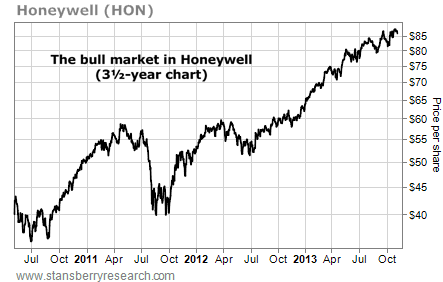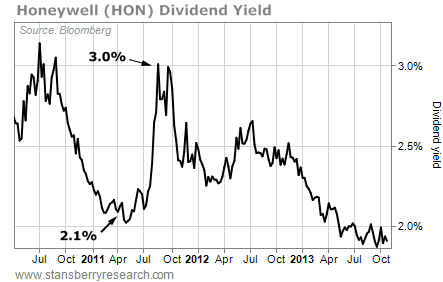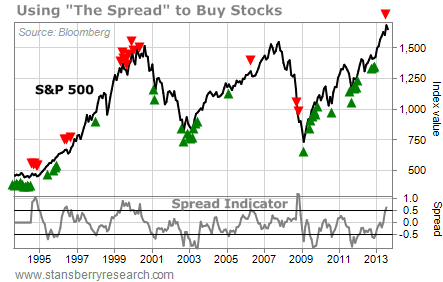 I’ve developed a method of timing income investments that allows you to collect higher dividend payments and larger capital gains.
I’ve developed a method of timing income investments that allows you to collect higher dividend payments and larger capital gains.
This bit of timing can add $86,000 in profits to your portfolio. I’ll show you how today.
I’m not keeping any secrets, either. I’ll lay out the whole technique in this short article. As you’ll see, it makes sense…
As the price of a dividend stock moves up, its yield moves down and vice versa.
[ad#Google Adsense 336×280-IA]Obviously, all other things equal, you want to buy when the yield is high.
That’s going to give you bigger dividend payments.
It’s also going to give you larger capital gains.
Take Honeywell (HON), for example.
This manufacturing giant has paid dividends every year since 1887.
Not many companies can say that.
And over the last four years, the stock has been in a huge bull market…
 You could have bought at any time during this run, and you’d be sitting on gains right now… But there’s a simple way to maximize the gains you get from stocks like Honeywell.
You could have bought at any time during this run, and you’d be sitting on gains right now… But there’s a simple way to maximize the gains you get from stocks like Honeywell.
Take a look at the next chart. It shows Honeywell’s dividend yield since mid-2010. You can see how it moved from 3%… down near 2%… back up to 3%… and back down to 2%.
 That might not sound like much difference… But timing your purchases to when the dividend yield is relatively high (3% versus 2%) dramatically improves your results.
That might not sound like much difference… But timing your purchases to when the dividend yield is relatively high (3% versus 2%) dramatically improves your results.
An investor who bought in early 2011 when the yield was low, near 2%, made 39% in capital gains on his Honeywell shares. An investor who bought in late 2011 when the yield was high, near 3%, made 93% in capital gains (plus, collected bigger dividend payments).
Of course, most folks get scared when share prices are down… and yields are up… That can make timing your income investments a challenge. That’s why I developed a timing indicator that pinpoints exactly when I should buy.
Here’s how it works, using the big benchmark S&P 500 stock index as an example…
First, to judge the yield on stocks, you need something to compare it to. All alone, you don’t know if a 2% yield is high or low. So I start by comparing the yield on 10-year corporate bonds with the dividend yield on the S&P 500.
The difference between the two yields is the “spread.” So if corporate bonds yield 4.5% and stocks yield 2.5%, the spread is 4.5% minus 2.5%, which equals 2%.
If you watch the historical patterns of that spread, you can get a good idea of when stocks are expensive and when they are cheap.
But I take it one step further…
I compare the size of the spread right now to the average of the spread over the last year. This helps me pinpoint short-term selloffs, which often make great buying points. It also helps identify when stocks have gotten overvalued… and when it’s time to consider an exit.
When it comes to the S&P 500, the indicator isn’t always perfect… But if you buy when the indicator is low (below -0.5), you’ll usually get in when stocks are ready to move higher. And if you sell when the indicator is high (above 0.5), you’ll often get out ahead of major selloffs.
 Over the long term, the gains add up: If you’d simply bought stocks in 1995 and held on, you’d have 209% in capital gains. If you’d used this method, you’d have 295% in capital gains.
Over the long term, the gains add up: If you’d simply bought stocks in 1995 and held on, you’d have 209% in capital gains. If you’d used this method, you’d have 295% in capital gains.
On a $100,000 portfolio, that’s an $86,000 difference. Huge.
Right now, the indicator is flashing “sell.” That doesn’t mean I expect a massive selloff in stocks. But it does mean I’m making sure that every fund or stock I recommend is a great value in its own right. It means I’m running a similar “test” on every dividend sector I consider, like REITs, MLPs, and more.
Over the next couple days, I’ll show you what I’ve found…
Here’s to our health, wealth, and a great retirement,
Dr. David Eifrig
[ad#stansberry-ps]
Source: The Growth Stock Wire

